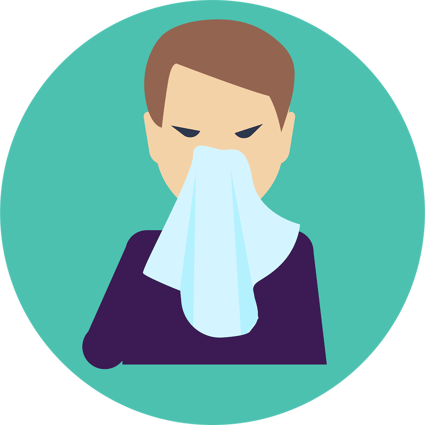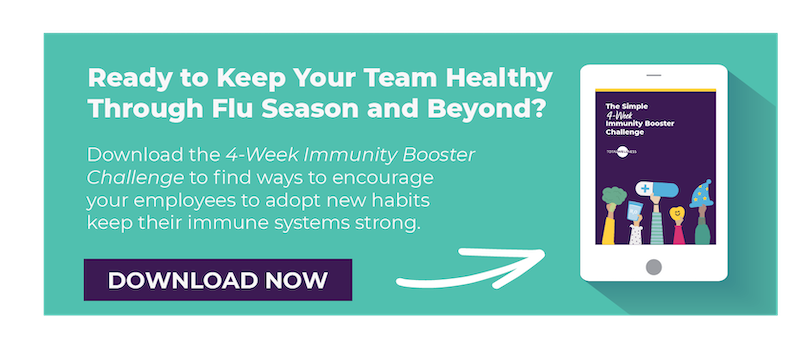 For some people, allergies are an irritating part of everyday life.
For some people, allergies are an irritating part of everyday life.
The sneezing, watery, itchy eyes, and nasal congestion can feel neverending.
Annually, over 50 million Americans experience various allergies. It can be seasonal, but it’s technically always allergy season if you count irritants like pet dander and dust mites that collect on a variety of surfaces.
And if those types of environmental allergies are in your workplace, you’ll want to know how to deal with allergies — and the causes — promptly.
Not surprisingly, allergies are cited as the sixth leading cause of chronic illness in America, according to the Asthma and Allergy Foundation of America. If workplace allergies aren’t addressed, that could lead to absenteeism and ill workers.
Ready to learn how to nix some of the most common environmental allergens?
Below, we share common triggers and simple fixes to reduce allergens at work.
What Triggers Allergies at Work?
Some allergies may cause mild reactions in certain people — sneezing, coughing, sniffles — but for others, it can cause their bodies to go into anaphylactic shock. So, what types of allergies might be triggered inside and outside of a workplace?
The most common indoor/outdoor allergy triggers include:
- Mold spores
- Dust mites
- Cockroaches
- Cat, dog, and rodent dander
- Tree, grass, and weed pollen
Individuals who have seasonal allergies or specific reactions generally know how to deal with allergies in their own homes. But, in the workplace, it can be a little harder to pinpoint and/or deal with allergies. That’s when it becomes the responsibility of the employer to ensure the workplace is safe and free of certain allergens, like mold, for example.
Indoor allergens are the ones employers can have the most control over. If you notice employees consistently dealing with nasal allergies, sinus swelling, and complaining of difficulty breathing indoors, there may be a serious allergen issue in your workplace that requires professional intervention.
Inspect the Workplace for Allergens
A variety of allergens can impact the health of your workers in the workplace. Regular cleaning, building maintenance, and inspections can keep allergies at bay. Ensure the workplace is well-ventilated, too. As an employer, inspecting your workplace environment for allergen triggers can keep your workforce healthy throughout the entire year, not just during seasonal allergy periods. Spring, summer, and fall all bring their own allergens out to irritate allergy sufferers.
Some of the most common allergen triggers include:
- Dust
- Pollen
- Aerosols
- Humid air
- Fresh paint
- Pet dander
- Cockroaches
- Chemical fumes
- Cigarette smoke
- Mold and mildew
- Perfume and scented products
- Tobacco and wood smoke
Important note: When a company gets work done on a building, it can be tricky to remember all the logistics. However, during this process, don’t forget to keep your employees’ health in mind, too. Any time there is work being done on the building — like painting — ensure employees are notified in advance. This allows them to plan to relocate their office space, wear a mask, or bring in a personal air purifier, if needed.
Discover Why the Summer Season May Trigger Asthma Attacks For Some Employees
Natural Ways to Deal with Allergies in the Workplace
If you’re looking for cost-effective ways to keep your employees’ environments healthy without breaking the bank, you’re in luck. As with most health initiatives, there is some cost involved. But it’s worth it if your team is feeling healthier — and less sniffly — every time they come into work!
Some options to consider:
Air Purifiers
Certain allergens — like dust mites — tend to become airborne and easily contaminate the air. Air cleaners are one way to reduce air allergens. Depending on your company’s budget, you can invest in anything from a commercial-grade air cleaner or a personal portable air cleaner. When shopping, look for certified asthma and allergy-friendly filters and HEPA filters. Ultimately, though, the best way to improve air quality is to get rid of the allergen source completely.
Plants
Not only do plants brighten up work spaces, they provide significant health benefits, too. Office plants may improve moods, reduce stress, and increase productivity on top of keeping the air clean. NASA did a study that found certain plants — like spider plants, bamboo palms, and English Ivy — clean the air well and remove toxins like ammonia and toluene.
Learn how to Create a Healthier Office With These 7 Indoor Plants That Clean Air!
Create Specific Policies
One of the simplest, most affordable options to reduce allergens? Create policies around common allergens that can create health concerns for individuals. That includes a no smokingpolicy and no pets in the workplace policy. One that can also be helpful for those who are sensitive to scents is a “no strong scents rule” that requests individuals to refrain from the use of strong perfume, cologne, and lotions when coming into the workplace.
Regular Cleaning
This one is especially important when it comes to office workers’ health. Doing a weekly dusting of blinds and window drapery can keep dust mites away. Vacuuming daily is ideal to keep dust mites, pet dander, and other allergens out of the office.
The Asthma and Allergy Foundation of America recommends avoiding wall-to-wall carpet, if possible. Cleaning up food waste and covering garbage can also keep cockroaches — a common allergen — away from the workplace, too. If your office is small and you do the cleaning, be sure to wear a mask to prevent inhaling toxic chemicals.
Reduce Humidity
What adds humidity inside a building? Activities like cooking and washing dishes add moisture to the air. Heating appliances can also add unwanted moisture to the air as well.
During winter months, walls, doors, and windows that aren’t properly insulated are cool surfaces where droplets can form, creating a perfect environment for allergens like mold and mildew to grow on. A dehumidifier can help reduce humidity in workplace rooms like kitchens or non-ventilated rooms and prevent mold growth. The ideal humidity level is between 30-50%. A moisture meter can help you read the humidity level of your workplace.
Preventative Maintenance
Have inspectors come out and look for issues like poor ventilation and hidden moisture areas that can lead to an overgrowth of mold. It’s best to do this preventative maintenance on a quarterly or annual basis to avoid a serious workplace allergen issue that could put your workers’ health at risk.
Learning How to Deal With Allergies Creates a Safer Workplace
Any allergy sufferer will tell you they’ll do whatever they can to avoid dealing with cold-like symptoms year-round.
Whether you or your teammates suffer from allergies, do your best to take measures to create an allergen-free environment. This ensures workers can feel safe coming into work and stay healthy and productive, too.
Training your staff and leadership teams on recognizing life-threatening allergy reactions — whether it’s food or environmental — and how to respond can also create a safer workplace.
Additionally, it’s important to note the difference between COVID and allergy symptoms. Given the rise of COVID, allergy sufferers may stress they’ll be judged for coming into work if they’re congested and sneezing, despite knowing their allergies are flaring.
The symptoms that overlap between COVID and allergies include wheezing, sore throat, and headaches. Sneezing, nasal congestion, and a runny nose are more common in those dealing with allergies.
For any employees dealing with the loss of smell, shortness of breath, intense fatigue, or a dry cough, a temp check — and COVID test — may ease concerns for the employee and employer alike.
Learn more here about the difference between COVID-19 and allergy symptoms.
How do you keep your workplace free of allergens? Share your tips below!



